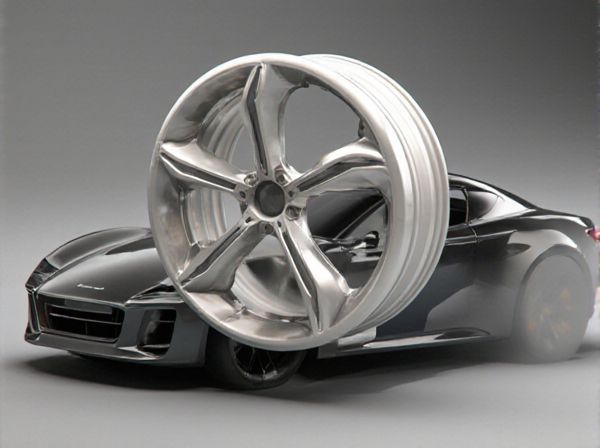
Photo illustration: Flow Formed vs Gravity Cast
Flow formed parts offer superior strength, durability, and dimensional accuracy compared to gravity cast components due to the intense pressure applied during manufacturing. Gravity casting allows molten metal to flow into molds by gravity alone, typically resulting in less dense and more porous products. Your choice between flow formed and gravity cast materials should consider performance requirements, as flow formed components better withstand stress and wear in demanding applications.
Table of Comparison
| Feature | Flow Formed Wheel | Gravity Cast Wheel |
|---|---|---|
| Manufacturing Process | Aluminum alloy reshaped under high pressure rollers | Molten aluminum poured into molds by gravity |
| Weight | Lighter due to denser, stronger structure | Heavier from less dense material alignment |
| Strength | Higher tensile strength and durability | Lower strength, more prone to cracking |
| Cost | More expensive due to advanced process | More affordable, mass-produced |
| Performance | Better handling and response; suited for sport or performance cars | Standard performance; best for casual use |
| Appearance Quality | Smoother finish, higher precision | May have surface imperfections |
| Common Applications | Sports cars, high-performance vehicles | Regular passenger vehicles, economy models |
Introduction to Flow Formed and Gravity Cast Wheels
Flow formed wheels utilize a process that combines casting and forging, where the wheel is spun and stretched under pressure to enhance strength and reduce weight. Gravity cast wheels are made by allowing molten aluminum to fill a mold through gravitational force, resulting in a more economical production with moderate strength. The flow forming technique produces wheels with superior mechanical properties and performance compared to the traditional gravity casting method.
What is Flow Formed Technology?
Flow formed technology is an advanced manufacturing process that enhances the strength and durability of metal components by applying high pressure to a spinning preform over a mandrel, resulting in refined grain structure and increased tensile strength. This method produces lighter, stronger wheels compared to traditional gravity cast wheels, which are made by pouring molten metal into molds without mechanical deformation. Flow formed products offer superior performance characteristics, including improved impact resistance and greater weight savings, making them ideal for high-performance automotive applications.
Understanding Gravity Cast Wheel Manufacturing
Gravity cast wheel manufacturing involves pouring molten aluminum into a mold, allowing the metal to solidify under the influence of gravity without additional pressure. This method produces wheels with adequate strength for everyday use but typically has lower tensile strength and fatigue resistance compared to flow-formed wheels. Gravity casting is cost-effective and ideal for standard vehicle applications where high-performance characteristics of flow forming are not essential.
Key Differences Between Flow Formed and Gravity Cast
Flow formed components undergo a mechanical process that compresses and shapes metal, resulting in enhanced strength, reduced weight, and improved grain structure compared to gravity cast parts. Gravity cast parts are produced by pouring molten metal into a mold and allowing it to solidify under gravity, leading to higher porosity and lower mechanical properties than flow formed counterparts. Key differences include flow formed parts exhibiting superior tensile strength and fatigue resistance, whereas gravity cast parts offer lower manufacturing costs but with less structural integrity.
Strength and Durability Comparison
Flow formed wheels exhibit superior strength and durability compared to gravity cast wheels due to their manufacturing process, which involves spinning and stretching alloy billets under high pressure to align the metal's grain structure. This results in wheels that have enhanced tensile strength and improved resistance to impact and fatigue, making them ideal for high-performance and off-road applications. Gravity cast wheels, produced by pouring molten metal into molds without additional pressure, are less dense and more prone to cracking and bending under extreme stress.
Weight and Performance Benefits
Flow formed wheels are significantly lighter than gravity cast wheels, reducing unsprung weight and improving vehicle acceleration and handling. The flow forming process enhances the wheel's strength and durability by elongating the aluminum grain structure, resulting in better performance under stress. Lighter wheels also contribute to improved fuel efficiency and reduced rotational inertia, offering measurable advantages for both daily driving and competitive applications.
Cost Considerations: Flow Formed vs Gravity Cast
Flow formed components generally incur higher initial setup and tooling costs compared to gravity cast parts due to the advanced machinery and precision required for material deformation. Gravity casting offers a cost-effective solution for low to medium production volumes as it requires simpler molds and less energy-intensive processes. However, flow forming delivers superior mechanical properties and material savings, potentially reducing long-term costs in high-performance applications.
Applications and Suitability for Drivers
Flow formed wheels offer enhanced strength and lighter weight, making them ideal for performance-oriented drivers seeking improved acceleration and handling, particularly in sports and racing applications. Gravity cast wheels, while heavier and less strong, provide a cost-effective option suitable for everyday driving and casual use where budget and aesthetics are prioritized over high performance. Drivers focused on durability and weight savings tend to prefer flow forming, whereas gravity casting suits those valuing affordability and standard driving conditions.
Pros and Cons of Flow Formed Wheels
Flow formed wheels offer enhanced strength and durability compared to gravity cast wheels, owing to the deformation process that aligns the metal grain structure. They are lighter than gravity cast wheels, improving vehicle performance and fuel efficiency, but typically come at a higher cost. However, flow formed wheels may have limited design options and require more complex manufacturing, impacting availability and repairability.
Pros and Cons of Gravity Cast Wheels
Gravity cast wheels offer a cost-effective manufacturing process that produces lightweight yet durable alloys ideal for everyday driving. Their primary advantage lies in lower production costs compared to flow formed wheels, making them accessible for budget-conscious consumers. However, gravity cast wheels may lack the structural strength and impact resistance of flow formed wheels, potentially leading to reduced performance under high-stress conditions such as racing or heavy load scenarios.
 caratoz.com
caratoz.com